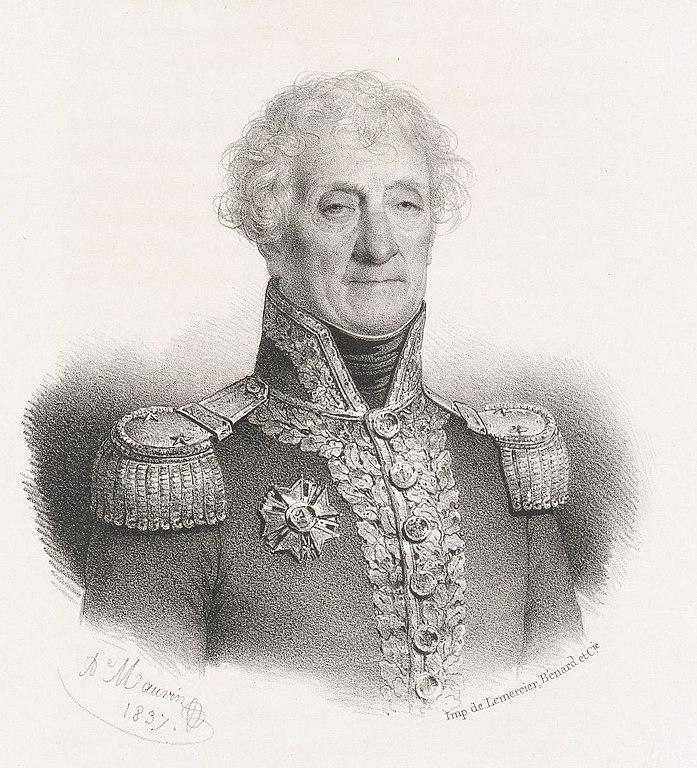
Jacques Félix Emmanuel Hamelin
Commodore Jacques Hamelin had not had an especially fruitful cruise in the Venus so far, but he was about to make life more difficult for the squadron than ever.
On 10 November a trio of Indiamen, 185 days out of Portsmouth bound for Calcutta, were midway across the Indian Ocean and, at a position of Lat 00° 56’S, probably preparing for the high jinks of Crossing the Line. It was a pleasantly mild day for these latitudes and, having left the Ile de France in their wake weeks ago, those on board may have been looking forward to their arrival in Bengal after what had been a long but entirely trouble-free voyage. That evening a sail was sighted – as it transpired, the Rattlesnake, an 18-gun sloop from Madras.
Commodore John Stewart of the Windham received a lieutenant on board and, after initial relief that the Navy had not come to press his crew, listened gravely to a report that two French frigates were in the vicinity. Stewart sent messages across to the other Indiamen, Charlton and United Kingdom. ‘I have reason to apprehend our meeting an Enemy of superior force,’ he wrote. Over the next week each ship exercised her great guns as they passed north until, on 17 November, they reached 06° 03’N – east of Ceylon and just a few degrees south of where the Caroline had intercepted Dale’s fleet in June.
At dawn of a thin calm morning, 18 November, three strange sail were sighted about twelve miles distant. They were Hamelin’s Venus, the 40-gun Manche, and the corvette Creole. Despite these absurdly one-sided odds, Stewart decided to attack. He addressed the crew from the quarterdeck, pointing to the Manche and telling them that she was to be their prize. She was too heavily armed for a straight fight, of course, but she was some distance ahead of Venus and Creole and Stewart said he intended to get in close and board her before the others came up.
The plan was breathtaking in its effrontery. The Manche’s 38-pounder carronades were not known as ‘smashers’ for nothing and at close quarters Windham would be quickly reduced by good gunnery to a splintered ruin. In the matter of numbers, the frigate had twice as many hands as the Indiaman. Stewart was putting his faith in a detachment of about 200 troops spread among his three ships.
His speech was reportedly cheered by the men before they went to their stations. A passenger similarly circumstanced wrote: ‘I could not help admiring the alacrity of the seamen – one would have thought by their looks and cheerful bustle that they were preparing for some jovial entertainment or grand festival.’ The response of the Windham’s passengers is not recorded. Those who were hustled below included a gentleman named Hunter, his sister, Mrs Scott – described as ‘a worthy Scotch lady of the old school’ – two sisters, the Miss McCargs, and two other young ladies, the Misses Barton and Button.
Stewart’s fellow captains watched all this aghast. Although he had ordered them to follow him into action, they did so with obvious reluctance and as Windham closed with the Frenchman, it was seen that Charlton and United Kingdom were not coming on at the same pace. Not to put too fine a point on it, they had shortened sail and fallen some miles behind.
Over the next two hours Windham exchanged heavy fire with Manche whose aim, fortuitously, was found wanting, so many balls hummed harmlessly overhead. But Stewart could not get close enough to board. Each time the Windham neared her, the frigate bore up and made sail. Eventually, Captain Dornal de Guy, perceiving his foe’s determination, wore round on the starboard tack to evade him one last time before breaking off at noon to rejoin the Venus. Four of the Windham’s crew were dead and the Indiaman had sustained a battering but it had been a gallant little action. Captain William D’Esterre of the United Kingdom wrote in his log that Stewart had ‘behaved most nobly’.
Windham remained in the background of the cannons blazing redly in the night as the French frigates set off in pursuit of less troublesome quarry, the other Indiamen. Stewart, in no position to come to their defence and perhaps feeling let down, tried to make his escape. At 11 p.m. on a still, clear and bright night, the Windham bore away to the north-west.
Now it was the United Kingdom and Charlton that had their hands full. ‘The French frigates and corvette were standing after us with all sail, bearing very fast,’ D’Esterre wrote. ‘At half past 12am Sunday morning commenced action, both frigates firing on us.’ In less than an hour both Indiamen had struck, United Kingdom with three men dead. The two captains were taken on board the Manche. In the meantime, Venus set off in pursuit of the Windham.
Stewart managed, despite the damage to his ship, to elude Hamelin for the rest of that day. Brought up from the orlop, Mrs Scott and the other ladies observed the desperate efforts made to escape: guns were cast overboard to lighten the load and running repairs made to rigging as the Windham raced on and on, into the night. And through the next day and night. Then yet another. Somehow, a damaged Indiaman was staying ahead of one of the fastest frigates afloat, thanks to the skill of her captain and the energy of her crew.
These exertions were followed admiringly from the Venus’s quarterdeck, where her officers were drawn to the spectacle in a spirit of fraternity. Hamelin remarked that ‘every credit was due to Windham’s captain’ while his juniors marvelled: ‘They did not conceive it possible that any ship could have escaped for so long.’